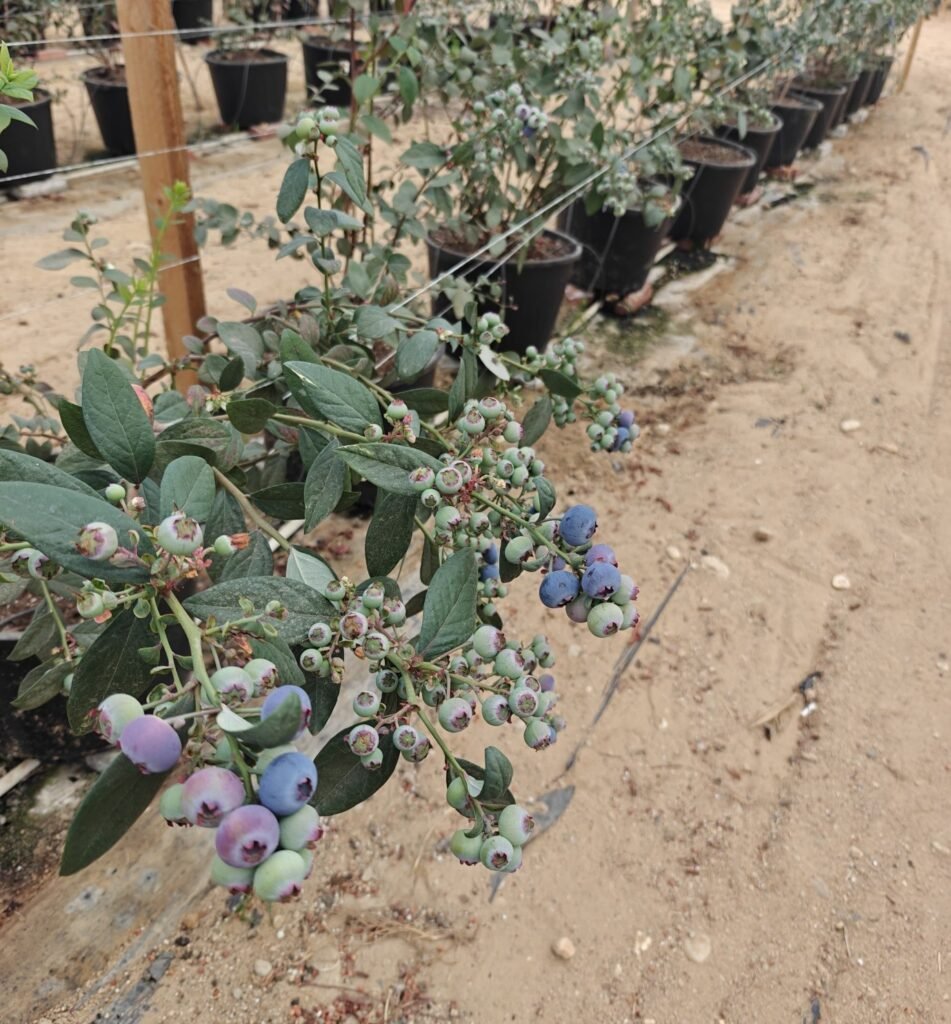
🌱 Introduction: Understanding the “Chill Factor” in Blueberries
As blueberry cultivation gains momentum across India, one concept often confuses new growers and investors: chilling requirements. What are they? Why do they matter? And how do they impact variety selection?
In this guide, we’ll simplify the difference between low-chill, high-chill, and zero-chill blueberry varieties—and help you choose the best blueberry varieties for India based on your region’s climate, altitude, and farm goals. Whether you’re planning a commercial blueberry project in Maharashtra, Himachal, Karnataka, or elsewhere in India. Understanding chilling requirements is crucial for your farm’s success.
❄️ What Are Chilling Requirements in Blueberries?
Blueberries need a specific amount of cold exposure (in hours below 7°C or 45°F) during winter to break dormancy and produce healthy spring growth and flowers. This is known as the chilling requirement.
- High Chill Varieties: Require 800–1200+ hours of chilling.
- Low Chill Varieties: Require 150–400 hours of chilling.
- Zero Chill Varieties: Can fruit even with minimal or no winter chilling.
👉 In most parts of India, especially the plains and warmer hill zones, low or zero chill varieties are essential for successful yields.
🌍 Types of Blueberry Plants: A Quick Overview
Understanding the genetic background helps in choosing varieties:
- Southern Highbush
- Bred for low chill requirements (150–500 hrs)
- Ideal for Indian subtropical and tropical climates
- Early bearing, heat-tolerant
- Northern Highbush
- Require high chill (800+ hrs)
- Suitable only for cold climates (e.g., Himachal high elevations)
- Poor performer in warm Indian winters
- Rabbiteye
- Chill requirement: 150–600 hrs
- Heat-tolerant, but often tall up to 15 feet, late bearing, and less preferred for high-density Indian projects
- Heat-tolerant, adopted to warmer climates of South eastern USA.
- Lowbush
- Wild type, cold-hardy, and not suitable for commercial farming in India

Why High-Chill Varieties Don’t Work in Most of India
High-chill varieties like classic Northern Highbush cultivars often fail to break dormancy in Indian winters. This leads to:
- Weak flowering
- Poor fruit set
- Delayed or no yield
Most Indian regions don’t meet the chill hours required—making Southern Highbush or low/zero chill hybrids a smarter choice.
🌱 Top Recommended Low-Chill & Zero-Chill Varieties for Indian Conditions
As India’s leading provider of turnkey solutions for blueberry farming, we offer expert guidance and access to elite low-chill blueberry varieties tailored for tropical and subtropical Indian conditions.
These five blueberry varieties—Cupla, Albus, Sentinel, Falcon, and Colossus—represent a diverse set of options for growers operating in India’s low to moderate chill regions. Each variety brings a unique combination of plant growth habits, berry characteristics, and cultivation flexibility, making them suitable for different climates, farming systems, and market goals. When matched correctly with local conditions and supported by proper agronomic practices, these varieties can serve as the foundation for a productive, scalable, and commercially viable blueberry farming venture.
Key Takeaway for Indian Growers & Agri-Investors
- Avoid high chill varieties unless you have >1000 chill hours/year (e.g., higher Himachal altitudes).
- Focus on Southern Highbush and zero chill hybrids for commercial success.
- Successful commercial blueberry farming in India begins with the right low-chill variety selection, region-specific site assessment, and strategic crop planning. This is where our end-to-end turnkey berry solutions make the difference
- Offering expert guidance on site selection, elite planting materials, climate-ready protected structures, precision fertigation systems, full agronomical support, and post-harvest management to ensure consistent yield, fruit quality, and long-term profitability.

Planning to Start a Blueberry Project in India?
At Cal Pacific Agri Solutions, we deliver turnkey support to help you build a profitable, future-ready Blueberry farm.
- Site Assessment & Layout – Climate and water evaluation with efficient farm design.
- Protected Structures – Custom polyhouses/tunnels for ideal growing conditions.
- Growing Media & Containers – Cocopeat mixes and optimized grow bags/pots.
- Planting Systems – Smart spacing and systems for maximum growth and ease.
- Irrigation & Fertigation – Automated drip with pH, EC, and nutrient control.
- Variety Selection – Low-chill, high-yield blueberries and other berries.
- Nutrition & Crop Management – Stage-specific nutrition, pruning & harvesting.
- Pest & Disease Management – IPM-based, low-residue solutions.
- Agri-Tech Integration – Climate and crop health monitoring tools.
- Post-Harvest & Cold Chain – Practices to maintain quality and extend shelf life.
- Ongoing Support – Virtual and offline expert guidance with regular follow-ups.
👉 Discover India’s first turnkey model for strawberries, blueberries, raspberries, and blackberries—crafted for progressive farmers, agri-investors, and agripreneurs.
🌱 Build Your High-Performance Blueberry Farm Today
Whether you’re farming in Maharashtra, Himachal, Andhra Pradesh, or Tamil Nadu, success begins with:
- Choosing the right low-chill varieties
- Implementing climate-smart turnkey solutions
- Leveraging expert agronomic and post-harvest support
Looking to start or scale a profitable berry farm in India?
Discover India’s first comprehensive turnkey model for strawberries, blueberries, raspberries, and blackberries—crafted specifically for progressive farmers, agri-investors, and agri-entrepreneurs like you.
Whether you’re planning to grow blueberries in Maharashtra, Andhra Pradesh, Himachal, or Tamil Nadu, choosing low-chill varieties and using climate-smart turnkey farming solutions is the key to success.
From variety selection to farm setup and post-harvest solutions, we guide you every step of the way to maximize your berry farm’s yield and profitability.
Let’s build your high-performance berry farm together!
📩 Contact us today:
Email: director@calpacificagri.com
FAQs: Chilling Requirement & Indian Blueberry Farming
Q1. Which blueberry varieties grow best in India’s warm climates?
A: Low-chill Southern Highbush varieties like Cupla, Albus, Sentinel, Falcon, and Colossus are best suited for India’s subtropical and tropical regions.
Q2. What are chilling hours, and why do they matter in blueberry farming?
A: Chilling hours are the number of cold hours (below 7°C) required for blueberry plants to break dormancy and flower properly. Insufficient chilling leads to poor yields.
Q3. Can blueberries grow successfully in Maharashtra and Karnataka?
A: Yes! By choosing zero or low chill varieties and using proper cultivation techniques, blueberries can thrive in these warmer Indian states.
Q4. Are high chill blueberry varieties suitable for Indian farms?
A: Generally, no, because most Indian regions don’t get enough chilling hours. High chill varieties need 800+ hours, typical of colder climates like Himachal’s higher altitudes.
Q5. Can chilling requirements be artificially met for blueberries in India?
A: Artificial methods exist (dormancy-breaking chemicals, controlled cooling) but are expensive and complex. Selecting naturally adapted low-chill varieties is the best strategy.
Also Read: What are turnkey projects for berry farming?
#Blueberries #Blueberryfarming #BlueberryinIndia #Berryboom #TurnkeyProjects #Blueberryprojects #Blueberry #Blueberryplant #Blueberrybush #blueberrywhentoplant #Blueberrytree #Blueberrypicking #Blueberryfarm #blueberryvarieties #Blueberrycultivation #BlueberryvaritiesinIndia

Pingback: Future of Berry Farming in India: Why Technical Expertise -